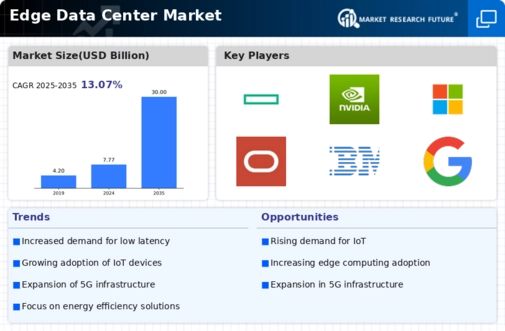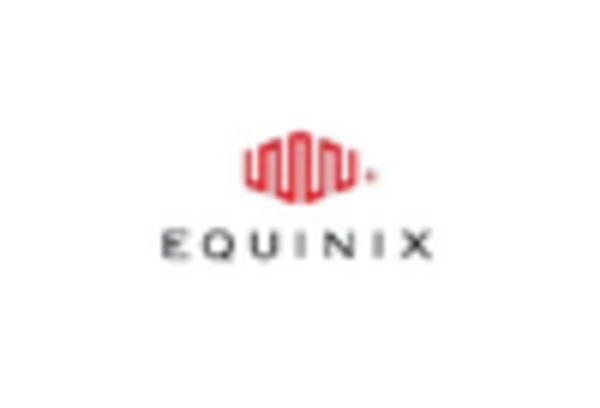IoT
Edge Computing
5G Networks
Content Delivery
Artificial Intelligence
Micro Data Centers
Modular Data Centers
Containerized Data Centers
Traditional Edge Data Centers
Hardware
Software
Services
On-Premises
Cloud
Hybrid
North America
Europe
South America
Asia Pacific
Middle East and Africa
North America Outlook (USD Billion, 2019-2035)
North America Edge Data Center Market by Application Type
IoT
Edge Computing
5G Networks
Content Delivery
Artificial Intelligence
North America Edge Data Center Market by Type
Micro Data Centers
Modular Data Centers
Containerized Data Centers
Traditional Edge Data Centers
North America Edge Data Center Market by Component Type
Hardware
Software
Services
North America Edge Data Center Market by Deployment Model Type
On-Premises
Cloud
Hybrid
North America Edge Data Center Market by Regional Type
US
Canada
US Outlook (USD Billion, 2019-2035)
US Edge Data Center Market by Application Type
IoT
Edge Computing
5G Networks
Content Delivery
Artificial Intelligence
US Edge Data Center Market by Type
Micro Data Centers
Modular Data Centers
Containerized Data Centers
Traditional Edge Data Centers
US Edge Data Center Market by Component Type
Hardware
Software
Services
US Edge Data Center Market by Deployment Model Type
On-Premises
Cloud
Hybrid
CANADA Outlook (USD Billion, 2019-2035)
CANADA Edge Data Center Market by Application Type
IoT
Edge Computing
5G Networks
Content Delivery
Artificial Intelligence
CANADA Edge Data Center Market by Type
Micro Data Centers
Modular Data Centers
Containerized Data Centers
Traditional Edge Data Centers
CANADA Edge Data Center Market by Component Type
Hardware
Software
Services
CANADA Edge Data Center Market by Deployment Model Type
On-Premises
Cloud
Hybrid
Europe Outlook (USD Billion, 2019-2035)
Europe Edge Data Center Market by Application Type
IoT
Edge Computing
5G Networks
Content Delivery
Artificial Intelligence
Europe Edge Data Center Market by Type
Micro Data Centers
Modular Data Centers
Containerized Data Centers
Traditional Edge Data Centers
Europe Edge Data Center Market by Component Type
Hardware
Software
Services
Europe Edge Data Center Market by Deployment Model Type
On-Premises
Cloud
Hybrid
Europe Edge Data Center Market by Regional Type
Germany
UK
France
Russia
Italy
Spain
Rest of Europe
GERMANY Outlook (USD Billion, 2019-2035)
GERMANY Edge Data Center Market by Application Type
IoT
Edge Computing
5G Networks
Content Delivery
Artificial Intelligence
GERMANY Edge Data Center Market by Type
Micro Data Centers
Modular Data Centers
Containerized Data Centers
Traditional Edge Data Centers
GERMANY Edge Data Center Market by Component Type
Hardware
Software
Services
GERMANY Edge Data Center Market by Deployment Model Type
On-Premises
Cloud
Hybrid
UK Outlook (USD Billion, 2019-2035)
UK Edge Data Center Market by Application Type
IoT
Edge Computing
5G Networks
Content Delivery
Artificial Intelligence
UK Edge Data Center Market by Type
Micro Data Centers
Modular Data Centers
Containerized Data Centers
Traditional Edge Data Centers
UK Edge Data Center Market by Component Type
Hardware
Software
Services
UK Edge Data Center Market by Deployment Model Type
On-Premises
Cloud
Hybrid
FRANCE Outlook (USD Billion, 2019-2035)
FRANCE Edge Data Center Market by Application Type
IoT
Edge Computing
5G Networks
Content Delivery
Artificial Intelligence
FRANCE Edge Data Center Market by Type
Micro Data Centers
Modular Data Centers
Containerized Data Centers
Traditional Edge Data Centers
FRANCE Edge Data Center Market by Component Type
Hardware
Software
Services
FRANCE Edge Data Center Market by Deployment Model Type
On-Premises
Cloud
Hybrid
RUSSIA Outlook (USD Billion, 2019-2035)
RUSSIA Edge Data Center Market by Application Type
IoT
Edge Computing
5G Networks
Content Delivery
Artificial Intelligence
RUSSIA Edge Data Center Market by Type
Micro Data Centers
Modular Data Centers
Containerized Data Centers
Traditional Edge Data Centers
RUSSIA Edge Data Center Market by Component Type
Hardware
Software
Services
RUSSIA Edge Data Center Market by Deployment Model Type
On-Premises
Cloud
Hybrid
ITALY Outlook (USD Billion, 2019-2035)
ITALY Edge Data Center Market by Application Type
IoT
Edge Computing
5G Networks
Content Delivery
Artificial Intelligence
ITALY Edge Data Center Market by Type
Micro Data Centers
Modular Data Centers
Containerized Data Centers
Traditional Edge Data Centers
ITALY Edge Data Center Market by Component Type
Hardware
Software
Services
ITALY Edge Data Center Market by Deployment Model Type
On-Premises
Cloud
Hybrid
SPAIN Outlook (USD Billion, 2019-2035)
SPAIN Edge Data Center Market by Application Type
IoT
Edge Computing
5G Networks
Content Delivery
Artificial Intelligence
SPAIN Edge Data Center Market by Type
Micro Data Centers
Modular Data Centers
Containerized Data Centers
Traditional Edge Data Centers
SPAIN Edge Data Center Market by Component Type
Hardware
Software
Services
SPAIN Edge Data Center Market by Deployment Model Type
On-Premises
Cloud
Hybrid
REST OF EUROPE Outlook (USD Billion, 2019-2035)
REST OF EUROPE Edge Data Center Market by Application Type
IoT
Edge Computing
5G Networks
Content Delivery
Artificial Intelligence
REST OF EUROPE Edge Data Center Market by Type
Micro Data Centers
Modular Data Centers
Containerized Data Centers
Traditional Edge Data Centers
REST OF EUROPE Edge Data Center Market by Component Type
Hardware
Software
Services
REST OF EUROPE Edge Data Center Market by Deployment Model Type
On-Premises
Cloud
Hybrid
APAC Outlook (USD Billion, 2019-2035)
APAC Edge Data Center Market by Application Type
IoT
Edge Computing
5G Networks
Content Delivery
Artificial Intelligence
APAC Edge Data Center Market by Type
Micro Data Centers
Modular Data Centers
Containerized Data Centers
Traditional Edge Data Centers
APAC Edge Data Center Market by Component Type
Hardware
Software
Services
APAC Edge Data Center Market by Deployment Model Type
On-Premises
Cloud
Hybrid
APAC Edge Data Center Market by Regional Type
China
India
Japan
South Korea
Malaysia
Thailand
Indonesia
Rest of APAC
CHINA Outlook (USD Billion, 2019-2035)
CHINA Edge Data Center Market by Application Type
IoT
Edge Computing
5G Networks
Content Delivery
Artificial Intelligence
CHINA Edge Data Center Market by Type
Micro Data Centers
Modular Data Centers
Containerized Data Centers
Traditional Edge Data Centers
CHINA Edge Data Center Market by Component Type
Hardware
Software
Services
CHINA Edge Data Center Market by Deployment Model Type
On-Premises
Cloud
Hybrid
INDIA Outlook (USD Billion, 2019-2035)
INDIA Edge Data Center Market by Application Type
IoT
Edge Computing
5G Networks
Content Delivery
Artificial Intelligence
INDIA Edge Data Center Market by Type
Micro Data Centers
Modular Data Centers
Containerized Data Centers
Traditional Edge Data Centers
INDIA Edge Data Center Market by Component Type
Hardware
Software
Services
INDIA Edge Data Center Market by Deployment Model Type
On-Premises
Cloud
Hybrid
JAPAN Outlook (USD Billion, 2019-2035)
JAPAN Edge Data Center Market by Application Type
IoT
Edge Computing
5G Networks
Content Delivery
Artificial Intelligence
JAPAN Edge Data Center Market by Type
Micro Data Centers
Modular Data Centers
Containerized Data Centers
Traditional Edge Data Centers
JAPAN Edge Data Center Market by Component Type
Hardware
Software
Services
JAPAN Edge Data Center Market by Deployment Model Type
On-Premises
Cloud
Hybrid
SOUTH KOREA Outlook (USD Billion, 2019-2035)
SOUTH KOREA Edge Data Center Market by Application Type
IoT
Edge Computing
5G Networks
Content Delivery
Artificial Intelligence
SOUTH KOREA Edge Data Center Market by Type
Micro Data Centers
Modular Data Centers
Containerized Data Centers
Traditional Edge Data Centers
SOUTH KOREA Edge Data Center Market by Component Type
Hardware
Software
Services
SOUTH KOREA Edge Data Center Market by Deployment Model Type
On-Premises
Cloud
Hybrid
MALAYSIA Outlook (USD Billion, 2019-2035)
MALAYSIA Edge Data Center Market by Application Type
IoT
Edge Computing
5G Networks
Content Delivery
Artificial Intelligence
MALAYSIA Edge Data Center Market by Type
Micro Data Centers
Modular Data Centers
Containerized Data Centers
Traditional Edge Data Centers
MALAYSIA Edge Data Center Market by Component Type
Hardware
Software
Services
MALAYSIA Edge Data Center Market by Deployment Model Type
On-Premises
Cloud
Hybrid
THAILAND Outlook (USD Billion, 2019-2035)
THAILAND Edge Data Center Market by Application Type
IoT
Edge Computing
5G Networks
Content Delivery
Artificial Intelligence
THAILAND Edge Data Center Market by Type
Micro Data Centers
Modular Data Centers
Containerized Data Centers
Traditional Edge Data Centers
THAILAND Edge Data Center Market by Component Type
Hardware
Software
Services
THAILAND Edge Data Center Market by Deployment Model Type
On-Premises
Cloud
Hybrid
INDONESIA Outlook (USD Billion, 2019-2035)
INDONESIA Edge Data Center Market by Application Type
IoT
Edge Computing
5G Networks
Content Delivery
Artificial Intelligence
INDONESIA Edge Data Center Market by Type
Micro Data Centers
Modular Data Centers
Containerized Data Centers
Traditional Edge Data Centers
INDONESIA Edge Data Center Market by Component Type
Hardware
Software
Services
INDONESIA Edge Data Center Market by Deployment Model Type
On-Premises
Cloud
Hybrid
REST OF APAC Outlook (USD Billion, 2019-2035)
REST OF APAC Edge Data Center Market by Application Type
IoT
Edge Computing
5G Networks
Content Delivery
Artificial Intelligence
REST OF APAC Edge Data Center Market by Type
Micro Data Centers
Modular Data Centers
Containerized Data Centers
Traditional Edge Data Centers
REST OF APAC Edge Data Center Market by Component Type
Hardware
Software
Services
REST OF APAC Edge Data Center Market by Deployment Model Type
On-Premises
Cloud
Hybrid
South America Outlook (USD Billion, 2019-2035)
South America Edge Data Center Market by Application Type
IoT
Edge Computing
5G Networks
Content Delivery
Artificial Intelligence
South America Edge Data Center Market by Type
Micro Data Centers
Modular Data Centers
Containerized Data Centers
Traditional Edge Data Centers
South America Edge Data Center Market by Component Type
Hardware
Software
Services
South America Edge Data Center Market by Deployment Model Type
On-Premises
Cloud
Hybrid
South America Edge Data Center Market by Regional Type
Brazil
Mexico
Argentina
Rest of South America
BRAZIL Outlook (USD Billion, 2019-2035)
BRAZIL Edge Data Center Market by Application Type
IoT
Edge Computing
5G Networks
Content Delivery
Artificial Intelligence
BRAZIL Edge Data Center Market by Type
Micro Data Centers
Modular Data Centers
Containerized Data Centers
Traditional Edge Data Centers
BRAZIL Edge Data Center Market by Component Type
Hardware
Software
Services
BRAZIL Edge Data Center Market by Deployment Model Type
On-Premises
Cloud
Hybrid
MEXICO Outlook (USD Billion, 2019-2035)
MEXICO Edge Data Center Market by Application Type
IoT
Edge Computing
5G Networks
Content Delivery
Artificial Intelligence
MEXICO Edge Data Center Market by Type
Micro Data Centers
Modular Data Centers
Containerized Data Centers
Traditional Edge Data Centers
MEXICO Edge Data Center Market by Component Type
Hardware
Software
Services
MEXICO Edge Data Center Market by Deployment Model Type
On-Premises
Cloud
Hybrid
ARGENTINA Outlook (USD Billion, 2019-2035)
ARGENTINA Edge Data Center Market by Application Type
IoT
Edge Computing
5G Networks
Content Delivery
Artificial Intelligence
ARGENTINA Edge Data Center Market by Type
Micro Data Centers
Modular Data Centers
Containerized Data Centers
Traditional Edge Data Centers
ARGENTINA Edge Data Center Market by Component Type
Hardware
Software
Services
ARGENTINA Edge Data Center Market by Deployment Model Type
On-Premises
Cloud
Hybrid
REST OF SOUTH AMERICA Outlook (USD Billion, 2019-2035)
REST OF SOUTH AMERICA Edge Data Center Market by Application Type
IoT
Edge Computing
5G Networks
Content Delivery
Artificial Intelligence
REST OF SOUTH AMERICA Edge Data Center Market by Type
Micro Data Centers
Modular Data Centers
Containerized Data Centers
Traditional Edge Data Centers
REST OF SOUTH AMERICA Edge Data Center Market by Component Type
Hardware
Software
Services
REST OF SOUTH AMERICA Edge Data Center Market by Deployment Model Type
On-Premises
Cloud
Hybrid
MEA Outlook (USD Billion, 2019-2035)
MEA Edge Data Center Market by Application Type
IoT
Edge Computing
5G Networks
Content Delivery
Artificial Intelligence
MEA Edge Data Center Market by Type
Micro Data Centers
Modular Data Centers
Containerized Data Centers
Traditional Edge Data Centers
MEA Edge Data Center Market by Component Type
Hardware
Software
Services
MEA Edge Data Center Market by Deployment Model Type
On-Premises
Cloud
Hybrid
MEA Edge Data Center Market by Regional Type
GCC Countries
South Africa
Rest of MEA
GCC COUNTRIES Outlook (USD Billion, 2019-2035)
GCC COUNTRIES Edge Data Center Market by Application Type
IoT
Edge Computing
5G Networks
Content Delivery
Artificial Intelligence
GCC COUNTRIES Edge Data Center Market by Type
Micro Data Centers
Modular Data Centers
Containerized Data Centers
Traditional Edge Data Centers
GCC COUNTRIES Edge Data Center Market by Component Type
Hardware
Software
Services
GCC COUNTRIES Edge Data Center Market by Deployment Model Type
On-Premises
Cloud
Hybrid
SOUTH AFRICA Outlook (USD Billion, 2019-2035)
SOUTH AFRICA Edge Data Center Market by Application Type
IoT
Edge Computing
5G Networks
Content Delivery
Artificial Intelligence
SOUTH AFRICA Edge Data Center Market by Type
Micro Data Centers
Modular Data Centers
Containerized Data Centers
Traditional Edge Data Centers
SOUTH AFRICA Edge Data Center Market by Component Type
Hardware
Software
Services
SOUTH AFRICA Edge Data Center Market by Deployment Model Type
On-Premises
Cloud
Hybrid
REST OF MEA Outlook (USD Billion, 2019-2035)
REST OF MEA Edge Data Center Market by Application Type
IoT
Edge Computing
5G Networks
Content Delivery
Artificial Intelligence
REST OF MEA Edge Data Center Market by Type
Micro Data Centers
Modular Data Centers
Containerized Data Centers
Traditional Edge Data Centers
REST OF MEA Edge Data Center Market by Component Type
Hardware
Software
Services
REST OF MEA Edge Data Center Market by Deployment Model Type
On-Premises
Cloud
Hybrid

















Leave a Comment